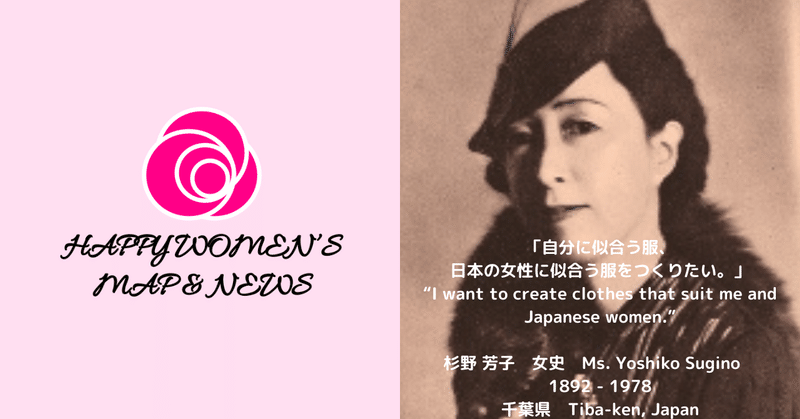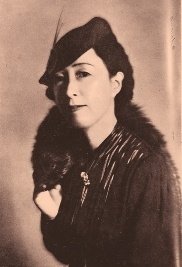
Happy Women's Map 千葉県 日本初ファッションデザイナー 杉野 芳子 女史

「自分に似合う服、日本の女性に似合う服をつくりたい」
"I want to create clothes that suit me and Japanese women."
杉野 芳子 女史
Ms. Yoshiko Sugino
1892 - 1978
千葉県山武郡横芝光町 生誕
Born in TYokoshimahikari-machi, Sanbu-gun, Tiba-ken
杉野芳子女史は日本初のファッションデザイナーです。日本で最初にファッションショーを日比谷公会堂で開催、日本女性に洋裁技術ならびに洋装文化を広く普及させました。「ドレメ式洋裁」の創案者、杉野女子大学学長、杉野学園ドレスメーカー学院創立者。
Ms. Yoshiko Sugino is Japan's first fashion designer and held the first fashion show in Japan at Hibiya Public Hall, widely promoting Western dressmaking techniques and culture among Japanese women. She is the creator of "Doreme-style Western-style dressmaking," the president of Sugino Women's University, and the founder of the Sugino Academy Dressmaker School.
*******
「アメリカへ行けば何かあるに違いない」
芳子は地主の家に生まれ、婿養子の父親を離縁した母親のもとで育ちます。幼い頃から海の向こうのアメリカの話を聞いて育ち、入学年齢前から袴をせがんで年上のきょうだいと一緒に小学校に通い、人形づくりに熱中しながら千葉高等女学校を卒業。鉄道省初の女性職員となり、その後3年間小学校教師として働きます。1913年に念願叶って着物に袴姿で単身渡米します。芳子はニューヨークで自分に合う服をつくろうと決意、洋裁技術ならびに活動的で手軽な洋装生活を身に付けます。やがて自分で作ったドレスを着た芳子は建築家・杉野繁一と出会い結婚、夫と共に帰国します。関東大震災を経て、女学校の制服また女子の職場の制服に洋服が取り入れられるようになると、主婦業に専念していた芳子は日本女性に洋装の楽しさを教えたいという思いが日々募ります。夫をやっとのことで説得し、1926年3人の生徒から洋装塾・ドレスメーカースクールを自宅で始めます。それぞれの体型に合う洋服を仕立てる芳子の技術が評判を呼んで生徒が押し寄せるようになります。ドレスメーカー女学院の教師また経営者として苦労する芳子を、夫が理事長として学校運営を担って助けます。
「これからは、どうしても活動的で手軽な洋装生活でなければいけない」
芳子は「ドレメ式原型」を開発、洋服に仕立て服(オーダーメイド)しかなかった時代に、標準的な型紙を使ったセミオーダーメイドや既製服(レディメイド)といった効率的な製作方法を教育します。1926年から読売新聞家庭面に芳子の洋裁記事が34回にわたり連載。子供また婦人の服・小物などの「型紙」付き記事は洋装の普及に貢献します。1936年日本初のファッション専門誌『D・M・J会誌』(ドレスメーカー女学院会誌)を創刊。1935年日本で最初のファッションショーを日比谷公会堂で開催。太平洋戦争が始まると、校舎は国に接収され分校舎も空襲で焼失。戦時下の物資不足の中でも芳子は様々なデザインを提案、国家が強制する女性の「正しい服装」更生服に対して、更生服のファッション展覧会を開催します。終戦後、再び自宅から授業を再開すると入学希望者が最寄りの駅まで長蛇の列をつくります。1957年ベニスで行われた「国際コットン・ショー」に作品を発表、日本人デザイナー初の海外進出を果たします。杉野芳子はピエールバルマン、クリスチャンディオール、ジャックファットなどに学院生のデザイン審査を依頼するなど親交を持ち、日本と欧米のファッションの架け橋を務めました。
“I will go to America and find purpose in life.”
Yoshiko was born into a landowner's family and grew up with a mother who divorced her adopted father. She grew up listening to stories about America across the ocean from an early age, and even before she was old enough to enter elementary school, she begged for a hakama and went to elementary school with her older siblings.She graduated from Chiba Girls' High School while being passionate about making dolls. She became the first female employee of the Ministry of Railways and then worked as an elementary school teacher for three years. In 1913, his wish came true and he went to the United States alone wearing a kimono and hakama. Yoshiko decides to make clothes that suit her in New York, and learns dressmaking skills and an active and easy lifestyle in Western clothing. Eventually, Yoshiko, wearing a dress she had made herself, met architect Shigekazu Sugino, married him, and returned to Japan with her husband. After the Great Kanto Earthquake, Western clothing began to be incorporated into girls' school uniforms and girls' workplace uniforms, and Yoshiko, who had been working as a housewife, felt a growing desire to teach Japanese women the joy of Western clothing. She finally persuaded her husband and in 1926, she started a Western clothing school/dressmaker school at her home with three students. Yoshiko's skill in tailoring clothes that fit each body type became popular and students started flocking to the school. Yoshiko is struggling as a teacher and manager at Dressmaker Girls' Academy, but her husband helps her by running the school as president.
"From now on, we have to live an active and easy-to-wear lifestyle."
Yoshiko developed the ``Dreme style prototype'' and taught people how to efficiently produce semi-custom and ready-made clothes using standard patterns at a time when only tailored clothing was available. Masu. Starting in 1926, Yoshiko's dressmaking articles were serialized 34 times in the home section of the Yomiuri Shimbun. Her articles with patterns for clothing and accessories for children and women contributed to the spread of Western clothing. In 1936, she launched Japan's first fashion magazine, D.M.J. In 1935, Japan's first fashion show was held at Hibiya Public Hall. When the Pacific War began, the school building was requisitioned by the government, and the branch building was also destroyed in an air raid. Even during the wartime shortage of supplies, Yoshiko proposes various designs and holds a fashion exhibition of men's clothing in response to the state-enforced "proper attire" for women. After the end of the war, she resumed classes from her home, and prospective students formed long lines at the nearest train station. In 1957, she exhibited her work at the International Cotton Show in Venice, making her the first Japanese designer to advance overseas. Yoshiko Sugino had close friendships with Pierre Balmain, Christian Dior, Jacques Fatt, and others, asking her to judge the designs of the school's students, and she served as a bridge between Japanese and Western fashion.
-杉野記念館 Sugino Memorial Museum
-ドレスメーカー学園 Doress Maker Gakuin

Share Your Love and Happy Women's Story!
あなたを元気にする女性の逸話をお寄せください!
Share your story of a woman that inspires you!
この記事が気に入ったらサポートをしてみませんか?
